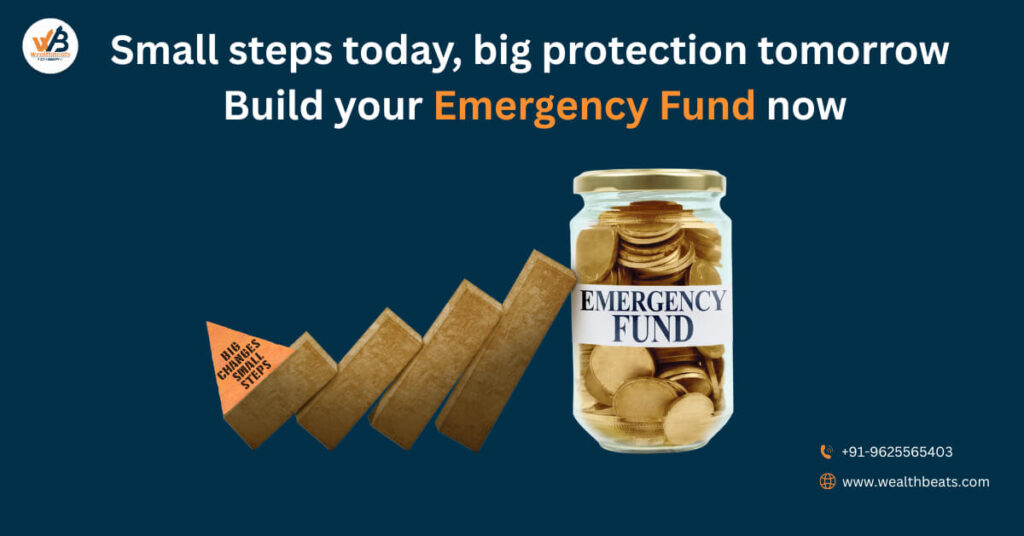
How to Build an Emergency Fund in India 2025 That Saves You
Imagine if one day you suddenly lose your job or need to pay for a medical emergency. Without any savings, you’d probably have to borrow money or use a credit card. Having an emergency reserve is therefore similar to having a safety ne This blog will show you how to build an emergency fund, even if you’re just starting small or earning a modest income. Everything is explained in simple language, so anyone can understand and take action.
- Save 3–6 months of basic expenses
- Use savings account, FD, or liquid funds
- Start small, stay consistent
- Never use for regular spending
Why Every Indian Needs an Emergency Fund
Life doesn’t always give warnings. A sudden illness, job loss, or car repair can put pressure on your savings. Without a backup fund, you may be forced to borrow money or break your long-term plans. An emergency fund acts like a cushion that protects your family from money stress. No matter your income, having one keeps you safe and worry-free.
An emergency fund is not just money. It’s freedom from fear when life takes a sudden turn.
1)The Harsh Reality of Not Having One
Many families in India are just one emergency away from financial trouble.
- 65% of Indian households can’t pay a medical bill above Rs. 30,000 without taking a loan.
- In cities, people face job cuts and high healthcare expenses frequently.
2)What Counts as a Real Emergency?
Some situations that call for emergency funds include:
- Job loss
- Sudden medical expenses
- House or car repair due to damage
- Death or illness in the family
- Natural calamities like floods or earthquakes
3) What Is Not an Emergency?
You should not use your emergency fund for:
- Holidays
- Big festival shopping
- Buying a new phone
- Paying for a wedding or vacation
How Much Emergency Fund Do You Need?
Your emergency fund should cover your basic monthly needs like rent, food, bills, and school fees. A good rule is to save 3 to 6 months’ worth of these expenses. If you live alone, aim for 3 months. If you have a family or dependents, save at least 6 months. Retired or self-employed? Plan for 9–12 months to stay safe during uncertain times.
Emergency savings may seem boring today, but they become your hero during life’s most unpredictable moments. Plan ahead, not in panic.
A) Use the 3–6 Month Rule
Your emergency fund should have enough money to cover 3 to 6 months of your basic monthly expenses:
- House rent or home loan EMI
- Grocery and food
- School fees
- Electricity, water, and mobile bills
- Health-related costs
B)Adjust Based on Your Life Situation
- If you are single and working: Save for 3 months of expenses
- If you are married with kids or dependents: Save for at least 6 months
- If you are retired: Keep 12 months or more as safety buffer
C)Divide Your Fund into Short-Term and Long-Term Needs
It’s smart to split your emergency fund into two parts:
- Short-Term Emergency Fund: This is the amount you may need immediately—for example, for a medical bill, job loss, or sudden travel. Keep this in a savings account or liquid mutual fund so you can access it quickly.
- Long-Term Emergency Fund: This covers bigger or long-lasting emergencies like long job loss, serious illness, or major home repairs. You can keep this in a sweep-in fixed deposit or a slightly higher-return option like a Money market fund.
This split ensures you always have some cash ready and some growing in the background.
Step-by-Step Guide: How to Save Your Emergency Fund

Step 1 – Know Your Basic Monthly Expense
Start by writing down what you truly need every month—like rent, food, medicine, and school fees. Don’t count spending on clothes, movies, or eating out.
Step 2 – Set Your Fund Goal
Multiply your basic monthly expense by 3, 6, or 12, depending on your situation. For example:
- Monthly expense: Rs. 15,000
- Target fund: Rs. 15,000 x 6 = Rs. 90,000
Step 3 – Start Saving, Even If It Is Small
Even saving Rs. 500 or Rs. 1000 every month makes a big difference.
Use SIP in a Liquid Mutual Fund (you can pause anytime)
Step 4 – Where to Keep Your Emergency Fund
You must keep your emergency fund in a place where it is safe and easy to take out when needed:
- Savings Account – Safe and easily accessible
- Sweep-in Fixed Deposit – Better interest, still liquid
- Liquid Mutual Funds – Good return, available in 1 working day
Step 5 – Automate the Saving Process
To make saving easy:
- Set auto-debit from your salary account
Step 6 – Check & Refill Your Fund
Every 6 months, check if the fund is enough.
- Used part of it? Add it back gradually.
- Expenses increased? Adjust the goal amount.
Also read: Managing Cash Flow in Retirement to prepare for later life stages.
How to Secure Your Emergency Fund
Saving your emergency fund is only half the job. The other half is to protect it so that it’s always there when you need it. Here’s how to keep your emergency fund safe and ready, explained in simple words:
1. Dont Keep It All in Cash at Home
Although keeping money in a cupboard or under your mattress may seem simple, it’s dangerous.. It can get stolen, lost, or damaged in a fire or flood. Also, cash doesn’t earn any interest—it just sits there losing value.
Better Option: Keep a small amount (like Rs. 5,000–10,000) at home for quick use. Put the rest in a bank or liquid mutual fund.
2. Use Safe and Quick Access Accounts
Put your emergency money in places that are safe and easy to withdraw:
- Savings Account – No risk, easy access
- Sweep-in Fixed Deposit – Grows your money and is still available when needed
- Liquid Mutual Funds – Gives better returns and money comes in 1 working day
3. Never Mix with Investment Money
Your emergency fund is not for buying shares or doing risky investments. If the market crashes, your money could disappear. Always keep your emergency fund separate from your other investments.
4. Tell Your Family Where It Is
If something happens to you, your family should know where the emergency fund is. Share details with a trusted family member—like your spouse or parent—so they can access it when needed.
5. Keep It Updated and Refill It
Used some of your fund for a real emergency? Great job using it for the right reason. But don’t forget to refill it. Also, check every 6 months if your needs have changed. Expenses go up, and your fund should grow too.
6. Use Strong Passwords and Secure Apps
If your fund is in a bank app or mutual fund platform, always use strong passwords and don’t share OTPs with anyone. This keeps your money safe from online fraud.
Remember: Your emergency fund is your financial shield. Don’t let it get rusty or stolen.
Real-Life Case Study – Jaipur Family Builds Rs. 2.85 Lakh Fund
Case Study: Rajiv & Meena’s Journey
Rajiv and Meena, a working couple in Jaipur with two school-going children, had no savings when the pandemic hit. They faced a salary cut and a health emergency. After things stabilized, they decided to build a strong emergency fund.
- Monthly expenses: Rs. 45,000
- Fund goal: Rs. 2.7 Lakhs (6 months)
- Plan: Rs. 5,000 monthly SIP in Liquid Fund
- Timeline: 9 months
They used a part of this fund during a dengue emergency in 2023 and felt relieved not having to borrow. They quickly refilled the fund again in 6 months.
Today, they feel proud and secure knowing they can handle life’s surprises.
Planning to build your emergency fund using SIP?
Common Mistakes You Should Avoid
- Using emergency money for regular shopping or festivals
- Keeping all of it in cash at home (it loses value due to inflation)
- Mixing this fund with stock market investments
- Not telling your family members where the fund is kept
Conclusion
To go beyond just protecting yourself and truly grow your money, learn how to make your savings work for you. Check out our full guide on How to Create Wealth.
Think of your emergency fund like an umbrella. You don’t use it every day, but when it rains—you’re glad it’s there. Start small, stay regular, and build your corpus.
Don’t wait for trouble to knock at your door. Start your fund today—even if you earn less, because something is always better than nothing.
Want help creating a custom emergency plan? Talk to a Wealthbeats Finserv Advisor. We’ll guide you based on your income, city, and life goals.
You can call on : +91-9625565403
“Download Your FREE Emergency Fund Starter Kit”
FAQ- Building Emergency Fund in India
Best options are liquid mutual funds or sweep-in FDs that give returns but are easy to withdraw.
Only if your monthly expense is Rs. 8,000–12,000. Most families should aim higher.
Avoid it. Credit cards charge interest. Emergency funds don’t add debt.
At least twice a year, or after big life changes like marriage, new job, or a child.
Contact Us
Table of Contents


Vineet Baheti,CFP
With over 14 years of experience in wealth management, I am expertise in comprehensive financial planning, including tax planning, retirement planning, and goal-based planning for High-Net-Worth (HNI) and Ultra-High-Net-Worth (UHNI) clients. As a Certified Financial Planner (CFP, Certification Number: IN94288), I provide personalized strategies to help clients achieve financial security, optimize their tax positions, and plan for a prosperous retirement. My approach is centered around building tailored financial plans that align with individual’s unique goals, ensuring their long-term financial success.
